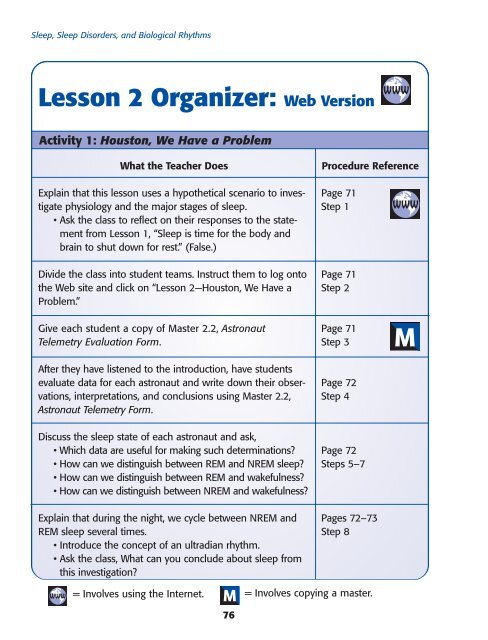Biological - NIH Office of Science Education - National Institutes of ...
Biological - NIH Office of Science Education - National Institutes of ...
Biological - NIH Office of Science Education - National Institutes of ...
You also want an ePaper? Increase the reach of your titles
YUMPU automatically turns print PDFs into web optimized ePapers that Google loves.
Sleep, Sleep Disorders, and <strong>Biological</strong> Rhythms<br />
Lesson 2 Organizer: Web Version<br />
Activity 1: Houston, We Have a Problem<br />
What the Teacher Does<br />
Explain that this lesson uses a hypothetical scenario to investigate<br />
physiology and the major stages <strong>of</strong> sleep.<br />
• Ask the class to reflect on their responses to the statement<br />
from Lesson 1, “Sleep is time for the body and<br />
brain to shut down for rest.” (False.)<br />
Divide the class into student teams. Instruct them to log onto<br />
the Web site and click on “Lesson 2—Houston, We Have a<br />
Problem.”<br />
Give each student a copy <strong>of</strong> Master 2.2, Astronaut<br />
Telemetry Evaluation Form.<br />
After they have listened to the introduction, have students<br />
evaluate data for each astronaut and write down their observations,<br />
interpretations, and conclusions using Master 2.2,<br />
Astronaut Telemetry Form.<br />
Discuss the sleep state <strong>of</strong> each astronaut and ask,<br />
• Which data are useful for making such determinations?<br />
• How can we distinguish between REM and NREM sleep?<br />
• How can we distinguish between REM and wakefulness?<br />
• How can we distinguish between NREM and wakefulness?<br />
Explain that during the night, we cycle between NREM and<br />
REM sleep several times.<br />
• Introduce the concept <strong>of</strong> an ultradian rhythm.<br />
• Ask the class, What can you conclude about sleep from<br />
this investigation?<br />
Procedure Reference<br />
Page 71<br />
Step 1<br />
Page 71<br />
Step 2<br />
Page 71<br />
Step 3<br />
Page 72<br />
Step 4<br />
Page 72<br />
Steps 5–7<br />
Pages 72–73<br />
Step 8<br />
= Involves using the Internet. = Involves copying a master.<br />
76

















